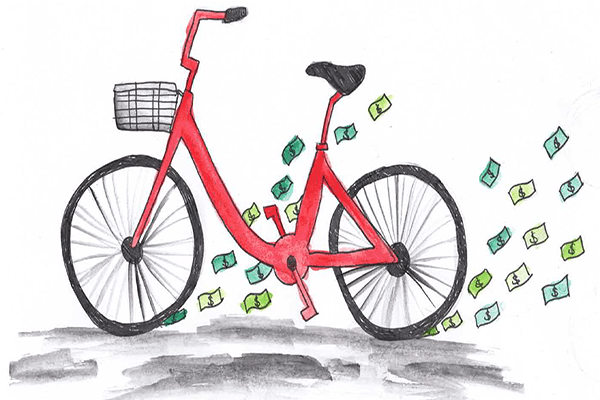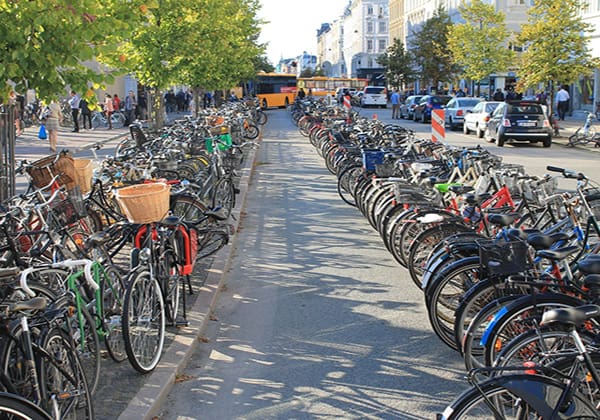Share bikes have had it rough.
Since first gracing the streets of Sydney in 2017, these vibrant visions of a car-less future have been often found atop trees, perched on fences, or piled up by the side of the road. The first time I saw one, it was precariously balanced on the railing of a pedestrian bridge over a canal somewhere in Annandale.
To recall the image of the bright green, graffiti-covered bike sitting there, literally teetering on the brink of becoming urban detritus, brings to mind a great debate around the bikes themselves: They’re a novel and environmentally-friendly alternative to the drudgery of public transport and the fuel consumption of cars, but at what cost?
The uptake of dockless share bikes has presented numerous challenges since the beginning. In mid-2018, share bike operator Ofo (bright yellow) decided to cease operating in Australia, after widespread vandalism and little oversight from the company brought widespread public outcry, with some Councils left responsible for impounding abandoned bikes. Despite suggestions that the problem with dockless share bikes was merely the lack of parking infrastructure to support them, the supply of bikes continued to dwindle and they had inconspicuously vanished by the start of the pandemic. However, the last quarter of 2020 saw them re-emerge with a vengeance. Across Inner Sydney, the major players are now Lime (bright red with smatterings of green), Mobike/Onyahbike (silver and orange), and Beam (violet). Predictably, their return again brought the ire of various local governments, who condemned their haphazard distribution and maintenance as doomed to once more dot the urban landscape like obtrusive, un-commissioned art installations.

This post-pandemic renaissance marked the first time I actually rode one — and I found myself instantly sold. My first voyage was atop a Lime bike. In the spur of the moment I had downloaded the app while at work and planned to ride the nearest bike home. I punched in my card details and scurried down the road as the app instructed, spotting the Lime on a dimly-lit street corner. It beckoned. There I was, hurtling down the footpath along Parramatta Road late at night in a flagrant breach of numerous cycling regulations. The experience was freeing, but the price of this euphoria? A dollar to unlock it via QR code and a further 45 cents per minute, amounting to a hefty $6.85 for a 13-minute trip. This was only mildly cheaper than an Uber over the same distance of about two and a half kilometres, more than three times as expensive than catching the bus, and more time-consuming than either. While the effortless mobility of soaring around on a pedal assisted bike is undeniable, and spotting one sitting stationary in the street is akin to the excitement of running into a good friend in public, their expense in Sydney prevents them from becoming an everyday convenience. This begs the question: with cheaper alternatives available, who exactly are these bikes for?
On March 30, the NSW Government published the Future Transport Technology Roadmap 2021-2024, a 50 page document envisioning the bright and ambitious future of “customer-focused transport technology” in NSW. Among its six priority programs is a plan to fully integrate public transport with on-demand ride-share and micro mobility services — like share bikes — via a digital Opal card, with a $3 credit for commuters who use multiple modes of transport within an hour. While investing in the potential of share bikes is promising, a narrow-sighted view of them as but a link in the chain of an interconnected transport utopia has its own issues. In other cities that have embraced bike share schemes like San Francisco, London, and Amsterdam, the bikes have quickly become a symbol of gentrification. A fun, forward-looking service, but only for those that can afford it. Less a cause and more of a symptom, these other cities have shown that where gentrification goes, cycling infrastructure and share bikes seem to follow. Arguably, the solution lies in share bike schemes being publicly-run. Hangzhou Public Bicycle, a docked bike scheme operated by the city’s Public Transport Corporation, has seen widespread adoption since its launch in 2006. Although it still faces the same logistical issues, there’s no credit incentive necessary since the first hour of use is free.
I’m not saying that share bikes cause gentrification. But the path to half-baked urban renewal is paved with well-intended bike share schemes. As urban development in Sydney continues towards the Metropolis of Three Cities vision for the latter half of the century, it is incumbent on the NSW Government and the private companies it seeks to partner with to factor the affordability and distribution of micromobility into their view of transport innovation. Lest they forever remain the way I occasionally get home when buses have stopped running for the night.





